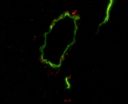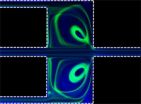(Press-News.org) Growing evidence suggests that there may be a link between diabetes and Alzheimer's disease, but the physiological mechanisms by which diabetes impacts brain function and cognition are not fully understood. In a new study published in Aging Cell, researchers at the Salk Institute for Biological Studies show, for the first time, that diabetes enhances the development of aging features that may underlie early pathological events in Alzheimer's.
Specifically, the Salk team found increases in two hallmarks of Alzheimer's-accumulations of amyloid beta (Abeta) and tau protein-in the brains of diabetic mice, especially in cells surrounding blood vessels. Abeta, the misfolded peptide that is thought in part to cause Alzheimer's disease, aggregated inside astrocytes, star-shaped brain cells that, upon interaction with Abeta, release inflammatory molecules that can destroy neurons. Previously, this had not been shown in mouse models of type 1 diabetes (T1D).
"Our study supports and extends the links between diabetes, aging and Alzheimer's," says senior author Pamela Maher, a senior staff scientist in Salk's Laboratory of Cellular Neurobiology. "We show that type 1 diabetes increases vascular-associated amyloid beta buildup in the brain and causes accelerated brain aging."
The findings suggest that the neurovascular system may be a good candidate for new therapeutic targets to treat Alzheimer's in the early stages of the disease.
Alzheimer's and diabetes are two diseases that are increasing at an alarming rate within the U.S. population. Alzheimer's affects one in 10 Americans over 65 years of age and nearly 50 percent of those over 85. Similarly, more than 8 percent of Americans (approximately 26 million people) have diabetes, with the vast majority of those individuals being over 60.
Maher says her team is uncertain of the precise mechanism behind the increase in Abeta and tau in the mouse brain, but their data suggest that changes in astrocytes, as well as other pro-inflammatory processes and the bonding of proteins with sugar molecules (called non-enzymatic glycation), may contribute.
"Astrocytes play a key role in maintaining nerve cells in the brain," says lead study author Antonio Currais, a postdoctoral researcher at Salk. "Both chronic peripheral inflammation and increased non-enzymatic glycation are associated with diabetes, and these changes may act on the brain to alter astrocyte function, which eventually leads to Alzheimer's-like changes."
All nerve cells are closely connected to blood vessels, as they need nutrients---- especially glucose (sugar) and oxygen---- provided by the blood in order to function. Astrocytes facilitate the transfer of nutrients between blood vessels and cells. The buildup of Abeta at sites where astrocytes interact with blood vessels suggest that this could impair the transfer of nutrients. The type of Abeta localization seen in Maher's mouse models is also found in human Alzheimer's patients
To examine the contributions of diabetes to Alzheimer's-related pathology in the aged brain, the Salk researchers induced T1D in two sets of mouse models. One set, known as SAMP8 mice, undergo accelerated aging and develop early deterioration in learning and memory, as well as a number of brain alterations similar to those found in Alzheimer's. The other set, SAMR1 mice, which in this study came from the same gene pool as the SAMP8 mice, age normally.
Using these mice, Maher and her colleagues addressed how T1D interacts with age to contribute to Alzheimer's-related pathology. They showed that T1D elicits a wide range of pathological changes in the brains of both strains of mice, which are exacerbated by premature aging.
The Salk study is the first to show that these modifications are similar to those seen in old nondiabetic SAMP8 mice and to identify unique pathological changes, such as increases in markers for inflammation, in aged, T1D SAMP8 mice.
Unlike most mouse studies of Alzheimer's, Maher's mice were not engineered to produce high levels of human Abeta or tau,so all of their observations came from naturally occurringAbeta and tau.
INFORMATION:
Other researchers on the study were Marguerite Prior and Professor David Schubert, from Salk's Laboratory for Cellular Neurobiology; David Lo, from Salk's Laboratory of Neuronal Structure and Function; and Corinne Jolivalt of the University of California, San Diego.
The work was supported by the National Institutes of Health, the Fritz B. Burns Foundation, the Bundy Foundation, Fundação para a Ciência e a Tecnologia and the Alzheimer's Association.
Salk study finds diabetes raises levels of proteins linked to Alzheimer's features
Mouse model may provide clues on mechanism linking diabetes and aging to Alzheimer's
2012-10-26
ELSE PRESS RELEASES FROM THIS DATE:
Footwear forensics
2012-10-26
A new computer algorithm can analyze the footwear marks left at a crime scene according to clusters of footwear types, makes and tread patterns even if the imprint recorded by crime scene investigators is distorted or only a partial print.
Footwear marks are found at crime scenes much more commonly than fingerprints, writes a team from the University at Buffalo, New York, in a forthcoming issue of the International Journal of Granular Computing, Rough Sets and Intelligent Systems. They point out that while footprints are common they are often left unused by forensic scientists ...
'NHS should replace traditional autopsies with non-invasive alternative'
2012-10-26
The NHS should implement a non-invasive alternative to autopsies, according to a Department of Health-commissioned report by leading UK experts within the field of post-mortem cross-sectional imaging.
The NHS Implementation Sub-Group of the Department of Health's Post Mortem, Forensic and Disaster Imaging Group (PMFDI) has called on the NHS to adopt post-mortem cross-sectional imaging for as an adjunct to, and under the right circumstances, a replacement for autopsies.
The group, chaired by Professor Guy Rutty, Chief Forensic Pathologist to the East Midlands Forensic ...
Media and content digitization benefits consumers, but revenues lag behind
2012-10-26
Digital spending - the acquisition of media products in digital format - tripled from 2006 to 2010 worldwide, with the recording music sector now achieving 30% of its global sales in the digital market. The digital success of the music sector contrasts other media and content industries, which are moving at a slower pace towards digital with distribution. Only 6% of film/video, newspapers, magazines and book sales were digital, according to the Joint Research Centre's (JRC) report on "The media and content industries. A quantitative overview", which represents an important ...
New options for ease and accuracy in extraction of rare cells or separating blood
2012-10-26
At the Sixteenth International Conference on Miniaturized Systems for Chemistry and Life Sciences (microTAS) to be held Oct. 28-Nov. 1, in Okinawa, Japan, University of Cincinnati researchers will present four papers, including one detailing improvements in rare cell isolation and one detailing improvements, in terms of cost and time, of common blood tests.
Ian Papautsky, associate professor in UC's School of Electronic and Computing Systems (SECS), part of the College of Engineering and Applied Science, and a UC team are leading these research efforts.
In a paper titled ...
Magnetic brain stimulation treats depression independent of sleep effect
2012-10-26
AUGUSTA, Ga. – While powerful magnetic stimulation of the frontal lobe of the brain can alleviate symptoms of depression, those receiving the treatment did not report effects on sleep or arousal commonly seen with antidepressant medications, researchers say.
"People's sleep gets better as their depression improves, but the treatment doesn't itself cause sedation or insomnia." said Dr. Peter B. Rosenquist, Vice Chair of the Department of Psychiatry and Health Behavior at the Medical College of Georgia at Georgia Health Sciences University.
The finding resulted from ...
Minimizing mining damage with manure
2012-10-26
This press release is available in Spanish.U.S. Department of Agriculture (USDA) research confirms that the time-tested practice of amending crop soils with manure also can help restore soils on damaged post-mining landscapes.
Thousands of acres of land with little or no vegetation, once mined for lead and zinc, remain throughout an area of southwestern Missouri, southeastern Kansas, and northeastern Oklahoma. The mining activities also left behind a legacy of lead-contaminated acidic soils, toxic smelter sites, and large quantities of mine tailings called "chat."
Soil ...
Mayo Clinic researchers develop new tools to better treat ADHD patients in early stages
2012-10-26
SAN FRANCISCO -- Mayo Clinic researchers are presenting new findings on the early treatment of child and adolescent attention deficit hyperactivity disorder this week at the American Academy of Childhood and Adolescent Psychiatry annual meeting in San Francisco. They include a method to get better input from parents and teachers of children who are being diagnosed with ADHD for the first time -- allowing for more effective treatment upon the first consultation. Researchers also showed how a tool can help clinicians better diagnose and treat children who have both ADHD and ...
Moffitt Researchers find genetic predictors of fatigue for some prostate cancer patients
2012-10-26
Researchers at Moffitt Cancer Center and the University of South Florida have found that men with prostate cancer who receive androgen deprivation therapy may predictably suffer from fatigue if they have single nucleotide polymorphisms in three pro-inflammatory genes. The discovery highlights the importance of personalized medicine, in which therapies are tailored to a patient's genetic profile.
The study appears in the October issue of Brain, Behavior, and Immunity.
"Few studies have examined the role of genes in cancer-related fatigue and none, to our knowledge, ...
ESDM early intervention improves brain activity associated with social cues
2012-10-26
(NEW YORK, N.Y., October 26, 2012) – The Early Start Denver Model (ESDM), a comprehensive behavioral early intervention program that is appropriate for children with autism spectrum disorder (ASD) as young as 12 months, has been found to be effective in improving social skills and brain responses to social cues in a randomized controlled study published online today in the Journal of the American Academy of Child & Adolescent Psychiatry.
"So much of a toddler's learning involves social interaction, and early intervention that promotes attention to people and social ...
Autism early intervention found to normalize brain activity in children as young as 18 months
2012-10-26
An intensive early intervention therapy that is effective for improving cognition and language skills among very young children with autism also normalizes their brain activity, decreases their autism symptoms and improves their social skills, a nationwide study has found. The researchers said the study is the first to demonstrate that an autism early intervention program can normalize brain activity.
"We know that infant brains are quite malleable and previously demonstrated that this therapy capitalizes on the potential of learning that an infant brain has in order ...
LAST 30 PRESS RELEASES:
Scientists use ultrasound to soften and treat cancer tumors without damaging healthy tissue
Community swimming program for Black youth boosts skills, sense of belonging, study finds
Specific depressive symptoms in midlife linked to increased dementia risk
An ‘illuminating’ design sheds light on cholesterol
Who is more likely to get long COVID?
Study showcases resilience and rapid growth of “living rocks”
Naval Research Lab diver earns Office of Naval Research 2025 Sailor of the Year
New Mayo-led study establishes practical definition for rapidly progressive dementia
Fossil fuel industry’s “climate false solutions” reinforce its power and aggravate environmental injustice
Researchers reveal bias in a widely used measure of algorithm performance
Alcohol causes cancer. A study from IOCB Prague confirms damage to DNA and shows how cells defend against it
Hidden viruses in wastewater treatment may shape public health risks, study finds
Unlock the power of nature: how biomass can transform climate mitigation
Biochar reshapes hidden soil microbes that capture carbon dioxide in farmland
Reducing saturated fat intake shows mortality benefit, but only in high-risk individuals
Manta rays create mobile ecosystems, study finds
Study: Mixed results in using lipoic acid to treat progressive multiple sclerosis
Norbert Holtkamp appointed director of Fermi National Accelerator Laboratory
New agentic AI platform accelerates advanced optics design
Biologists discover neurons use physical signals — not electricity — to stabilize communication
Researchers discover that a hormone can access the brain by hitchhiking
University of Oklahoma researcher awarded funding to pursue AI-powered material design
Exploring how the visual system recovers following injury
Support for parents with infants at pediatric check-ups leads to better reading and math skills in elementary school
Kids’ behavioral health is a growing share of family health costs
Day & night: Cancer disrupts the brain’s natural rhythm
COVID-19 vaccination significantly reduces risk to pregnant women and baby
The role of vaccination in maternal and perinatal outcomes associated with COVID-19 in pregnancy
Mayo Clinic smartwatch system helps parents shorten and defuse children's severe tantrums early
Behavioral health spending spikes to 40% of all children’s health expenditures, nearly doubling in a decade
[Press-News.org] Salk study finds diabetes raises levels of proteins linked to Alzheimer's featuresMouse model may provide clues on mechanism linking diabetes and aging to Alzheimer's



